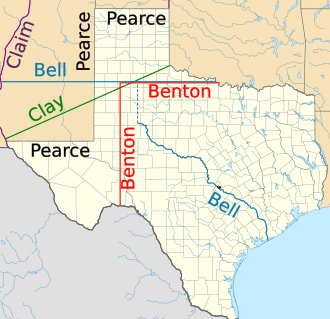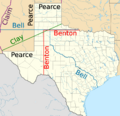Texas divisionism facts for kids
Texas divisionism is a historical idea about splitting the U.S. state of Texas into several smaller states. Some people believe this is allowed because of an agreement made when Texas joined the United States in 1845.
Texas is the second-largest state in the United States by both size and population. Supporters of division thought it was too big to be managed well as one state. They also believed that if Texas became several states, Texans would have more power in the national government. This is because each state gets two senators in the U.S. Senate and extra votes in the Electoral College. However, others argued that creating new states would be wasteful, as each new state would need its own government.
Contents
How New States Are Formed
The U.S. Constitution has rules about creating new states. It says that no new state can be formed from another state without the approval of both that state's government and the U.S. Congress.
When Texas joined the United States on March 1, 1845, Congress passed a special resolution. This resolution said:
Third – New States of convenient size not exceeding four in number, in addition to said State of Texas and having sufficient population, may, hereafter by the consent of said State, be formed out of the territory thereof, which shall be entitled to admission under the provisions of the Federal Constitution; and such states as may be formed out of the territory lying south of thirty-six degrees thirty minutes north latitude, commonly known as the Missouri Compromise Line, shall be admitted into the Union, with or without slavery, as the people of each State, asking admission shall desire; and in such State or States as shall be formed out of said territory, north of said Missouri Compromise Line, slavery, or involuntary servitude (except for crime) shall be prohibited.
Some people who wanted to divide Texas believed this 1845 resolution meant Congress had already given permission. They thought Texas could split into new states without asking Congress again. But others disagreed. They argued that the Constitution always requires new approval from Congress for any new states, even from Texas. They also pointed out that when Texas officially became a state on December 29, 1845, it joined "on an equal footing with the original States." This meant Texas had the same rights and rules as other states, which would include needing Congress's approval to divide.
Past Ideas for Dividing Texas
The idea of dividing Texas came up often in the years before and after the American Civil War.
Discussions in 1850
During the Compromise of 1850 discussions, Senator John Bell from Tennessee suggested splitting Texas into two southern states. This would have happened with Texas's agreement. His plan also involved giving some Texas land north of the 34th parallel north to New Mexico. The southern part of Texas would then be divided by the Colorado River into two new states.
The Proposed State of Lincoln
In 1869, during the Reconstruction period after the Civil War, there was a proposal for a new state called State of Lincoln. This state would have been created from the land in Texas south and west of the Colorado River. This idea was even presented to Congress, but the Texas government never fully approved it.
The Proposed State of Jefferson
In 1915, a bill was introduced in the Texas legislature to create a State of Jefferson. This new state would have included the area known as the Texas Panhandle.
The Idea of Texlahoma
In 1935, some people felt that the state government wasn't paying enough attention to roads in northern Texas. A man named A. P. Sights suggested that 46 counties in northern Texas and 23 counties in western Oklahoma should leave their states and form a new state called Texlahoma.
Modern Thoughts on Division
In 2009, a writer named Nate Silver looked into the idea of dividing Texas. He thought that splitting Texas might slightly help one political party in the Senate but hurt them in the Electoral College. He concluded that there wasn't a strong reason for either major political party to support dividing Texas.
Images for kids



